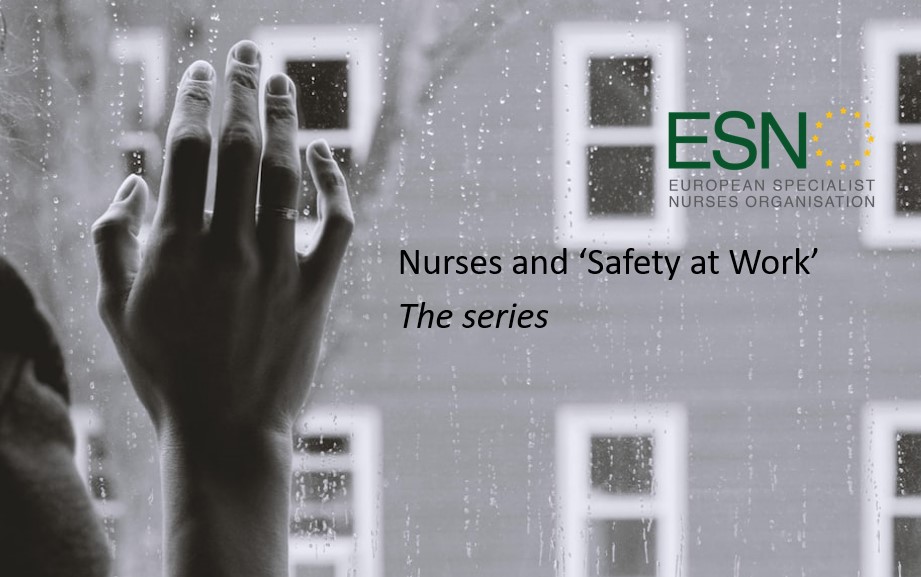
Background
Working as a nurse in today’s health environments is more demanding than ever. The expectations are higher with impact on the physical condition, but also related to aggression, working with chemicals, hazardous smoke but also for female nurses and nurses getting older. This project is to handles this one theme under a variety of sub chapters.
#1-Surgical smoke and air
To the background on a lack of comprehensive understanding of Surgical and hazardous Smoke and air where health professionals work, it’s in the ESNO interest to bring this to the attention of specialist nurses. The impact of unknown about the issues and neglect of using guidelines or available instruments and equipment is of great concern
See page Surgical Smoke
#2-Aggression, physical and verbal
‘Violence and harassment in the year of the nurse’ When the World Health Organisation (WHO) dedicated Year 2020 as “The Year of the Nurse and the Midwife”, nobody thought it would coincide with a global pandemic, putting the health sector at the forefront of the battle. ICN report – Finish report
#3-Nurses in aging position
Due to heavy workload but also increased stress and expectation, more nurses served decades are stepping out, or go with early retirement. This impacts brain drain of experience and above all a certain ‘seniority’ for new nurses coming in. It’s of vital importance that nurses in aging situation are save at work and have and work according their standards and use of capacity should not be wasted.
#4-Women in nursing profession
A vast majority of the workforce are female, and overall condition are often hard for them. Such as when their monthly period, pregnancy but also mother with additional responsibilities. Also the physical impact of the work and working with medication and chemicals. There needs to be a better policy based on research and recommendations implemented
#5-Nursing and Musculoskeletal impact
Nursing is very hard demanding in the physical domain, what we explicit had to observe when patients are en severe health condition. In the near future we will see an increase of elderly but also obesity with special demands for nurses. Extra time taking care for patients and use of proper lifting equipment’s is crucial.
#6-Working with chemicals and medication
When working in hospitals, environment of close to all condition, in closed spaces with air flow and conditioning. This environment can not always meet healthy situations especially when working with anti-sceptic, chemicals and medication. Due to often high pressure, standard are not often enough implemented. The impact of unhealthy environment has impact on health in the long term when neglected in early stage.
#7-Working under Pandemic conditions
It clear that we need a good scope of our health workforce and especially the nurses in times of new pandemic situation. It was clear, what happened over the past years during covid, we could not be prepared and this required immediate change. Only with a good balanced and health and competent workforce, they can act professional with a scope of confidence and sustainability.
#8-Sharp needles
Due to work pressure, we see that safety precautions are not always implemented and the requirements on directive on sharp needles are not met. The negative impact on sharp needle incidents leads that neglecting leads to ignorance, or worse, such as ‘bad luck’ or ‘part of the job’. To avoid this we see too less awareness campaign and implemented guidelines.
#9-Mental health in Nursing profession
Quality of care and patient safety goes parallel with good an reasonable working conditions such as balancing hours of work and relieve. This sub chapter project aims to provide advice and guidance for nurses to communicate with employers and regulators according to European directives and regulations. This will be based on experiences and studies in collaboration with European organisations related to working conditions..
#10-Sleep Work Ballance
With the increasing pressure on nurses, relate to nurse shortage making longer hours with less time to recover and covering each other in shifts gaps, it’s inevitable that that nurses spend less time in sleeping. Also the sleeping time is under pressure. Also in relation to night and day shift, an imbalance of a healthy wake and sleep balance is under threat. This has impact on nurses health but also on the quality of cate and patient safety. This chapter deals about safety at work related to a nurses health and sleeping problems.
#11-Sexual intimidation at work
Sexual harassment is complex and has occupational hazards in nursing. Nurses experienced it than other employees. Female nurses are with the highest rate in the profession. The aim of this module is to address provide explanation and prevalence of sexual harassment against female nurses, the types, perpetrators, and health consequences of the harassment. And important, guidelines to male’s in providing guidance in avoiding misbehaviour towards implementation of policies.
LINK
#12-Racism in the Nurses Workforce
It does not need much explanation that the majority of the nurses in Europe are often white and from the same region. However, in a fast growing multicultural society, we not only need to be more open to other cultures but also need to understand this. There is an absolute necessity to be aware of a multicultural health work society and address at the same time mistreatment of those nurses from colour and other cultural background.
Racism: Dismantling the Threat for Health Equity and the Nursing Profession
#13-Medication Errors
There are many initiatives and publication on medication errors, some with impact and immense health consequences. In this all, we also observe that it often the nurse, and especially in ICU and cancer case where the numbers are high. But in all, we need to underestimate about the impact for nurses, as second victim, while responsible to the situation but not to blame. Higher increase of work and stress leads to errors. This aspect is too often overlooked. This ‘blame’ culture is known as the ”Am I next to blame” with stepping out of responsible position or leave the profession.
#14-Fair renumeration and salaries
In the today crisis we also see with many others in the society that nurses, and categorically paid low’ are also victim of this all what leads that nurses are considering their profession when costs of daily living can not be paid. It’s of great relevance that nurses are fair paid, and not need to work absurd extra hours, irregular times, in making work hours.
#15-Education, Literacy and Training as part of Safety at work
About safety at work, including all the above mentioned themes, need to be frequent addressed in education and competence building as a part of safety at work. Too often this is taken for granted but to the background of lack of time, finance, certification and overall facilitation. Education as last resort investment in combination with increase of complex care, higher expectations leads to unsafe environment, for the patients and also nurses.. Without any doubts, when this addressed the with a certain frequency lead to a healthier and trustworthy workforce experience investment in their career paths and with a lower tendency of leaving the profession.
#16-Interdisciplinary discrimination.
Nurses leaving the profession of nursing and even health are also based on chronic experiences are not seldom based on ‘negative interdisciplinary discrimination’ and more concerning: because of the title ‘nurse’. Top clinical nurse experts with an impressive range of experiences, with high educated level with relevant roles, responsibility in a variety of health domain is not recognised, despite significant positive patient outcomes. This is also not encouraging for novice nurses, experiencing this at the start of there career..
There is a need to explore the intersectional nature of discrimination, the nature and extent of discrimination in the professional health domain, how it’s effecting clinical outcomes, social and economic. In addition, what action can be taken to tackle this discrimination with exploring the barriers preventing change and how hierarchy and dominancy can be prevented. In this process, there is a need of empirical findings about the nature and extent of discrimination, research articulating the experiences of those who have suffered discrimination in health and attempts to understand the intersectional nature of discrimination. With data and experiences enriched by storytelling the need is identified with theoretical and empirical understanding with policy recommendations for tackling and reducing this discrimination.
#17-Man in Nursing – tackling discrimination and stigma.
(Page in development)
Despite the growing number of men entering the profession, nursing remains a female-dominated field. According to the Bureau of Labor Statistics (BLS), only about 10% of registered nurses in 2013 were male. Due to tigmas, men may hesitate to consider nursing as a viable career path. These stigmas may prevent tens of thousands of talented and compassionate people from filling roles and reducing the nationwide nursing shortage. While many efforts have arisen to make STEM careers more accessible for women, experts argue that too few initiatives encourage men to serve as nurses or in other caregiver roles. As a result, nursing suffers from a lack of gender diversity that negatively affects both male and female nurses, as well as their patients. This page offers guidance and encouragement for men who are considering careers in nursing. Read on for key tips for male nurses and nursing students on pushing back against common stigmas.
